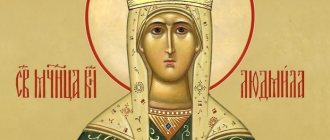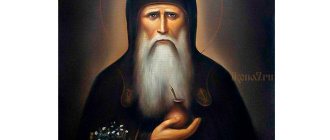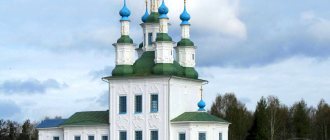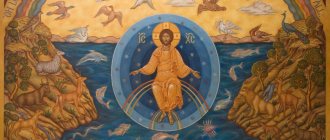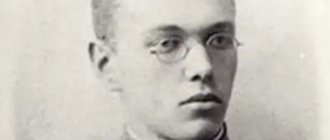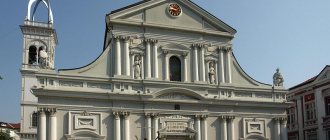Exaltation of the Holy Cross
Life-giving Cross
(Greek ὁ ζῳοποιὸς σταυρός), Cross of the Lord, Life-Giving Tree - the cross on which Jesus Christ was crucified.
It is one of the instruments of the Passion of Christ and belongs to the main Christian shrines. In honor of the discovery of the Life-giving Cross in 326, a holiday was established - the Exaltation of the Cross of the Lord
, which received its name from the fact that Bishop Macarius I, in order for all believers to see the Cross, erected (that is, raised) it, turning it to all cardinal directions .
See also: Church of the Holy Sepulcher
Historical excursion[edit]
Saints Equal-to-the-Apostles Constantine and Helen
After the greatest events in the history of mankind took place - the Crucifixion, Burial, Resurrection and Ascension of Christ, St. The cross, which served as the instrument of execution of the Savior, was lost. After the destruction of Jerusalem by Roman troops in 70 St. places associated with the earthly life of the Lord fell into oblivion, and pagan temples were built on some of them.
Finding St. The Cross took place during the reign of St. equal to imp. Constantine I the Great. According to church historians of the 4th century, Constantine’s mother, St. equal to Helena, at the request of the royal son, went to Jerusalem to find places connected with the events of the earthly life of Christ, as well as St. The cross, which became a miraculous phenomenon for St. Constantine is a sign of victory over the enemy.
Three different versions of the legend about the finding of St. Cross. According to the most ancient (it is given by the 5th century church historians Rufinus of Aquileia, Socrates, Sozomen, etc. and probably goes back to the lost “Church History” of Gelasius of Caesarea (IV century)), St. The cross was located under the pagan sanctuary of Aphrodite. When the sanctuary was destroyed, 3 crosses were discovered, as well as a tablet from the Cross of the Savior and nails. In order to find out which of the crosses is the one on which the Lord was crucified, Bishop of Jerusalem. Macarius († 333) suggested applying each of the crosses in turn to a seriously ill woman. When she was healed after touching one of the crosses, all those gathered glorified God, who pointed to the greatest shrine of the True Tree of the Cross of the Lord, and St. The cross was raised by Bishop. Macarius for public viewing.
Reliquary with part of the True Cross (Notre Dame Cathedral)
2nd version of the legend, which arose at the end. IV - beginning V century, reports that St. Elena tried to find out the location of the Cross from the Jerusalem Jews, and in the end one elderly Jew named Judas, who at first did not want to talk, after torture indicated the place - the Temple of Venus. St. Helena ordered to destroy the temple and excavate this place. 3 crosses were found there; A miracle helped to reveal the Cross of Christ - the resurrection through touching the True Tree of a dead man who was being carried past. It is reported about Judas that he subsequently converted to Christianity with the name Cyriacus and became the bishop of Jerusalem (Pigulevskaya. 1976). 3rd version of the legend about the finding of St. Cross, which arose in Syria in the 1st half. V century, refers this event not to the IV, but to the I century. and says that the Cross was found by Protonika (or Petronika), the wife of the emperor. Claudius I, and was subsequently hidden and found again in the 4th century. Despite the antiquity of the 1st version of the legend about the finding of St. Cross, as well as the fact that it is this version that is followed by the most authoritative Byzantine historians (for example, Theophanes), in the late Byzantine era the 2nd version became more widespread; in particular, the prologue legend intended for reading on the holiday of V. is based on it, according to modern times. liturgical books of the Orthodox Church.
Already by midday. IV century, as St. Cyril of Jerusalem, particles of the True Tree spread throughout Christ. to the world. In 2 destroyed Christian churches of the North, studied by archaeologists. Africa, inscriptions from 359 and 371 have been preserved, which mention the particles of the Holy Cross that were present in those churches. The fact that particles of the True Tree were even in the pectoral reliquaries of many. Christians, according to Saints Gregory of Nyssa and John Chrysostom.
Reliquary crosses with particles of the Life-Giving Cross have been known for a long time. Many Byzantine emperors and other members of the royal family had them. In Russia, this relic probably became known quite a long time ago - in one of the earliest monuments (1st half of the 11th century) of ancient Russian literature, Metropolitan Hilarion’s “Sermon on Law and Grace,” there is a mention of the Life-Giving Cross: “He [Emperor Constantine] with His mother Elena brought the Cross from Jerusalem [and], having sent it throughout the world, he confirmed the faith.”
Cross with a particle of the Honest and Life-Giving Cross of the Lord
One of the first relics of the Life-Giving Tree in Rus' was a particle in the cross of Euphrosyne of Polotsk, brought in the 12th century from Jerusalem, among other relics. A particle of the tree of the Cross was placed in the “Ark of Dionysius”, which in the wills of the Moscow Grand Dukes of the 15th century headed the list of shrines handed down by inheritance, and in the 17th – early 20th centuries was one of the most important shrines of the Annunciation Cathedral.
During the period of Nikon’s patriarchate in Russia, they began to make reliquary crosses “in the measure and likeness of the Cross of Christ.” One of them was the “Kiya Cross”, where, in addition to a particle of the Life-Giving Cross, 108 particles of the relics of saints and 16 stones from the sites of biblical events were placed.
Russian pilgrims to the Holy Land from the first half of the 19th century, from among especially eminent persons, received crosses with a particle of the Tree of the Holy Cross from the Patriarch of Jerusalem as a blessing, and later as a reward. The Order of the Cross with a particle of the Life-Giving Tree is currently the highest award of the Jerusalem Church.
, the holiday of the Exaltation of the Holy Cross was established
, which got its name from the fact that Bishop Macarius I, with the goal that all believers could see the Cross, erected (that is, raised) it, turning it to all cardinal directions. The same was done with the Cross after his return in 629 from Persia after 14 years of captivity back to Jerusalem under Emperor Heraclius.
The Feast of the Exaltation of the Precious and Life-Giving Cross of the Lord is celebrated by both the Orthodox and Catholic churches on September 14 (according to the Julian calendar in some Orthodox churches, and according to the Gregorian calendar in Catholicism).
A separate celebration was established in memory of Queen Helena's finding of the Lord's Cross and nails. In the Orthodox Church it takes place on March 6 (according to the Julian calendar), in the Catholic Church - on May 3.
In 2006, a particle of the Life-Giving Cross was delivered into low-Earth orbit.
What does the Cross symbolize?
The Honest Cross of the Lord is the unifying force of humanity. The two transverse bars of the Cross symbolize the union of people with God (vertical bar) and the union of people with each other (cross bar). Of course, the unification of people necessarily occurs through their relationship with God. The crossbar also symbolizes the two arms of the Crucified Savior, which are open to embrace and embrace all humanity.
The Holy Cross is a formidable weapon against dark forces. Before the crucifixion of Christ, the cross was used as an instrument of evil for destruction and death. After Christ volunteered to be crucified, the cross became a weapon against those who used it.
Believers now proudly wear the cross as a precious and effective bulwark against evil, but also as an acknowledgment of their faith in the great atoning sacrifice of Christ. It is worth noting the obvious disgust and even hatred of the Cross of Christ of many heretical Christian groups. In general, the Protestant world does not honor the Cross. It is known that Protestants do not cross themselves and use the cross only as an element.
The state of despair and bliss that the presence and sight of the Holy Cross evokes in our soul forces us to courageously and patiently endure life’s difficulties, that is, to bear our personal cross:
“Then Jesus said to His disciples, “If anyone wants to come after Me, let him deny himself, and take up his cross, and follow Me.” (Matt. 16:24)
We hope for the coming Resurrection, literally and figuratively. This unshakable faith gives us strength and makes us look at life with optimism.
Location. Accessibility for pilgrims[edit]
This table presents the most famous places in the Christian world for storing particles of the Life-Giving Cross.
| A country | Temple (Monastery) |
| Austria | Heiligenkreuz |
| Armenia | Echmiadzin |
| Belgium | Onthaalkerk Church in Bruges |
| Germany | Church of St. Cecilia, Dusseldorf |
| Greece | Athos monasteries: Iveron, Dionysiat, Kotlumush, Xiropotamus (part pierced with a nail), Philothea, Simonopetra, St. Paul, Stavronikita and Esphigmen - single particles; Great Lavra, Vatopedi, Hilandar, Pantokrator, Zograf and Caracal - several particles |
| Georgia | Svetitskhoveli Cathedral (particle). According to legend, part of the Cross, one of the nails, as well as the foot of the Cross were donated to Georgia by Emperor Constantine. The foot was lost under the Georgian king George XII |
| Israel | Church of the Holy Sepulcher - the largest known part of the Cross |
| Spain | Monastery of Santo Toribio de Liebana, Cantabria |
| Italy | Rome: St. Peter's Basilica, Basilica of Santa Croce in Gerusalemme, Pisa Cathedral, Santa Maria del Fiore in Florence |
| Cyprus | The Stavrovouni Monastery is a piece, according to legend, left by St. Helena at the founding of the monastery. The Monastery of the Holy Cross in the village of Omodos is a piece of the Cross and the bonds (ropes) that tied the hands of Jesus Christ on the way to the crucifixion. |
| Latvia | Cathedral of the Old Believer Grebenshchikov community in Riga. |
| Russia | Alexander-Svirsky Monastery, Annunciation Monastery (Nizhny Novgorod), Holy Cross Convent (Nizhny Novgorod), Epiphany Cathedral in Elokhov (Moscow), Resurrection-Fedorovsky Monastery, Holy Cross Monastery (Ekaterinburg), Pokrovsky Alexander Nevsky Monastery, Trinity Cathedral of the Trinity -Sergius Lavra, Church of Anastasia the Pattern Maker (Pskov), Holy Cross Kyltovo Convent, Temple of St. Sergius of Radonezh in Krapivniki. |
| Ukraine | Church of the Exaltation of the Cross (Vinnitsa), Cathedral of the Exaltation of the Cross (Uzhgorod), Assumption Cathedral (Mukachevo), Holy Dormition Pochaev Lavra, Church of the Exaltation of the Cross of the Kiev-Pechersk Lavra |
| France | Notre Dame Cathedral, Abbey of the Holy Cross, Poitiers (particle, from 568), Church of St. Claudius, Paris (particle brought from Jerusalem on July 28, 1109) |
| Montenegro | Cetinje is a particle that previously belonged to the Order of Malta, then located in Russia (Winter Palace and Gatchina, until 1917) |
Prayer to the Life-Giving Cross in Russian
Mark yourself with a cross and say a prayer to the Life-Giving Cross:
May God rise again, and may His enemies be scattered, and may those who hate Him flee from His presence. As smoke disappears, let them disappear; just as wax melts in the face of fire, so let demons perish from the face of those who love God and signify themselves with the sign of the cross, and who say in joy: Rejoice, Most Honorable and Life-Giving Cross of the Lord, drive away the demons by force on you of our Lord Jesus Christ, who descended into hell and straightened the power the devil, and who gave us His Honest Cross to drive away every adversary. O Most Honest and Life-Giving Cross of the Lord! Help me with the Holy Virgin Mary and with all the saints forever. Amen.
Monastery in Godenovo.
The church in Godenovo, which had always been a parish church, since 1997 became the courtyard of the St. Nicholas Convent of Pereslavl - and life in the village of Godenovo, which was dying out in the difficult 90s, received a new breath. The sisters of the monastery came here, the tradition of daily worship and reading of the akathist before the Life-Giving Cross was revived. A road was built to the village, the temple was visited by the famous professor Vladimir Mikhailovich Kurylev, who wrote a long article about the Goden Cross. People again reached out to the shrine, and again popular rumors spread about miracles of healing and God’s obvious help through prayer at the Life-Giving Cross. and in recent years, whenever you come to Godenovo, you can always see a lot of people - these are pilgrimage groups coming here on large buses from different cities of Russia, Ukraine, Belarus, Kazakhstan, and monks who got here from distant countries - Bulgaria , Greece, Serbia. Here you can meet Orthodox people from America, Germany, England, Malta - everyone comes to venerate the great shrine. And everyone finds at the Cross what they were looking for.
Miracles and healings at the Life-Giving Cross in Godenovo.
The author of these lines often travels with pilgrims to Godenovo, and over the course of several years he learned from them many cases of healings occurring at the Godenovo Cross. We'll tell you about them here.
One pilgrim signed up for a trip to Godenovo and went to the Life-Giving Cross in the spring of 2022. Several months have passed, and she signs up for a trip again, saying “I need to go, thank God.” And on the way back from Godenovo he tells his story. Before her first trip, doctors diagnosed her with laryngeal cancer. There were no prospects for a cure, the pain intensified, the tongue began to become stiff. And this woman decides to ask for help not from doctors, but from God, and goes to Godenovo. She shed many tears at the Cross and returned home in the evening. And the next morning I woke up and immediately realized that I was completely healthy! Not even traces of the terrible disease remained. The doctors just shrugged their shoulders - she no longer had any signs of cancer.
Another case was told by pilgrims from Yekaterinburg. One woman in their parish became completely blind, and the doctors could not do anything. But one of the parishioners who visited Godenovo brought her oil from the lamp burning at the Cross and water from the prayer service. The blind woman washed herself daily with this water for some time, and her vision began to return. Now she has fully received her sight, and every time someone from this parish goes to Godenovo, she is sure to bring both oil from the Cross and holy water from Godenovo to Yekaterinburg.
One of our pilgrims, upon arrival in Godenovo, took out a small paper bag with gold rings and crosses, and handed them over to decorate the Cross. She also wrote down her story in the journal of miracles performed at the Cross. For many years she was treated for infertility, but the doctors were relentless: “You will never be able to give birth to a child.” With fervent prayer, she and her husband came to the Life-Giving Cross, and a month and a half later she found out that she was pregnant. She gave birth to a beautiful girl, and when she was three years old, she collected gold jewelry and went to Godenovo. Thank God.
How to get to Godenovo.
Many pilgrims ask the question: “how to get to Godenovo on your own?” They go to the official website of Godenovo, created by the St. Nicholas Monastery.
We will briefly talk about the opportunity to visit Godenovo.
You can get to Godenovo by car in the following way: along the Yaroslavskoe highway you need to move to the city of Petrovsk (formerly the village of Petrovskoye), where opposite the traffic police department you need to turn right, following the sign “Godenovo Life-Giving Cross.” Having crossed the bridge over the railway, turn right, and then move about 15 km, following the signs (they are at every fork and intersection, it will be difficult to make a mistake. The last kilometers before Godenovo have very poor asphalt coverage, so be extremely careful. The total road from Moscow to Godenovo is about 180 kilometers, and takes , depending on the traffic situation, about three to three and a half hours.
If you decide to get to Godenovo by bus or train, you will need to first get to the city of Petrovsk, and then use the services of local taxi drivers, since there is no direct bus Moscow - Godenovo, but a local bus from Petrovsk to the village of Zakharovo (next to Godenovo) only walks a couple of times a day. Trains from the Yaroslavl direction go to Petrovsk with a transfer, the total travel time is from a little over three to five hours. Buses go to Petrovsk either from the Shchelkovskaya metro station or from the Severnye Vorota Bus Station. Travel time is from 5 to 7 hours. Departure times and routes can be found in the popular Yandex. Schedules"
But still, most often pilgrims get to Godenovo with pilgrimage services. Some services go to Godenovo on weekends two or three times a month, some every Sunday. The Makovets pilgrimage service makes trips to Godenovo from Moscow every Saturday and Sunday, on the Feasts of the Cross, during the entire Cross-Worship week of Great Lent, as well as on weekdays, when a group of 12 people or more is recruited. You can see the schedule of pilgrimage trips to Godenovo:
Origin of the life-giving tree
The history of the Life-giving Cross of the Lord is based on legends about the life-giving tree on which Jesus was crucified, but which still gives miracles of healing and liberation.
The Bible does not answer the question of what kind of wood was used to make the instrument of death on which Christ was crucified. In the Gospels it is already being prepared as an instrument of crucifixion.
Apocryphal sources store a lot of interesting reliable data about the origin of the legendary tree.
According to the legend of the Bogomils, a Christian movement of the 5th century that came from Bulgaria, the tree of paradise of good and evil fell into three parts during the expulsion of Adam and Eve. The central part remained in the Garden of Eden, and subsequently the Cross was made from it for the crucifixion of Christ.
According to the Golden Legend, Adam's son Seth went to the gates of the Garden of Eden with a request to give him oil to anoint his dying father. Archangel Michael refused him, saying that this oil was closed for 5.5 thousand years before the time of the birth of Jesus, but presented Seth with a branch from the tree of good and evil. Seth did not find his father alive; a wreath was woven from a branch of the legendary tree and placed on Adam’s head during burial.
Death of Adam, artist - Pierro Dela Francesca
From this branch subsequently grew a tree, cut down by the servants of King Solomon to build the temple in Jerusalem. Due to the discrepancy in size, it was used as a support for a bridge.
The Queen of Sheba, who had the gift of prophecy when visiting King Solomon, stopped near the bridge and knelt in front of the historical tree. According to her, this tree is destined to become an instrument of death for the Savior of the world, after which the Jews will face ruin.
King Solomon knew the Queen of Sheba and her gift of vision well. The prediction seriously frightened him. By order of the king, the tree was dismantled from the bridge and buried.
The wood of this timber was subsequently used to build a pool in Bethesda, whose water attracted the crippled with its healing qualities.
When Jesus was arrested, this tree emerged from the foot of the pool, a cypress from which the trunk of the Life-Giving Shrine was made, the crossbars were made of pine and cedar.
Important! The history of the life-giving Cross of the Lord formed the basis of the Feast of the First Savior, which is celebrated on August 14. It is popularly known as Honey Spas.
Why did Queen Helen look for the execution weapon?
And now let’s imagine a woman who lived for 80 years in such a perception of this execution, who suddenly fell in love with the instrument of another person’s death. Cross!
For me, the question has always been: why did Queen Helena, the elderly mother of Emperor Constantine, suddenly organize an expedition to Aelia Capitolina (present-day Jerusalem) for one thing: to find the Cross of Christ?! What exactly attracted this woman to such a task? Find the execution weapon? Yes. Execution of Jesus Christ. But why the execution weapon? Why wasn't she in a hurry to find other artifacts?
The legend and description of Eusebius of Caesarea reveal to us the features of the first written excavations of the queen. She herself did not leave the excavation site, not only supervising, but also actively participating. The elderly matron sat on the curule seat under a large umbrella all day, despite the scorching sun. She watched with interest the work of the hired diggers, encouraging them with small and light gold coins, like petals, which she threw into the garbage that they had to scoop out of the abandoned tank. And this forced them to throw out garbage faster to get to the desired gold.
